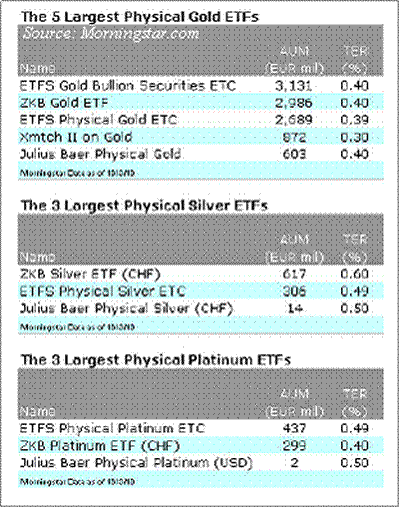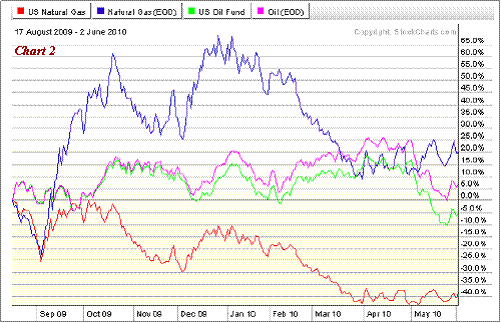Commodities, Time To Go Long and Physical
Commodities / Investing 2010 Jun 03, 2010 - 09:17 AM GMTBy: Dian_L_Chu
 Deutsche Bank AG recently noted that commodities will continue to “struggle” as the dollar strengthens and China seeks to restrain growth. Looking at the recent performance between the CRB index, S&P 500 and Legg Mason Emerging Market (LGEMX) would certainly seem to support Deutsche’s view. (Chart 1)
Deutsche Bank AG recently noted that commodities will continue to “struggle” as the dollar strengthens and China seeks to restrain growth. Looking at the recent performance between the CRB index, S&P 500 and Legg Mason Emerging Market (LGEMX) would certainly seem to support Deutsche’s view. (Chart 1)

Bears Gripping Commodity
Right now, due to the sluggish growth in industrialized nations, China remains the single largest consumer and buyer of many commodities.
Although China’s long term growth prospect remains strong, Beijing has started monetary tightening measures, amid concern of asset bubbles and inflation. The latest PMI data also suggests China economy could be slowing down.
Furthermore, with the euro and European Union saddled by PIIGS, dollar could continue to strengthen against euro in the near to medium term amid global risk aversion. Since most commodities are priced in dollar, a stronger dollar typically would depress the price and returns of commodities.
Market Over-reacting
The current momentum of key commodities including oil, copper and gold should be moving higher. This will happen as soon as investors feel less nervous about the Greek and European drama with the euro gaining support from four major central banks today, and signals of continuing easy monetary policy around the world.
The Gulf oil spill seems to be another event which the markets are having anxieties over. It is true that the Gulf oil spill disaster does have economic and environmental impact to the U.S. Gulf coast, but in the global scheme of things, this most likely will not cause significant enough impact to the fundamentals of crude oil or economic direction to warrant a full blown commodity bear market.
Instead, this recent pullback on commodities from market's mis-reaction should serve as a good entry point for long-term investors, and I will discuss a few options in the following sections. .
 Physical ETFs
Physical ETFs
Long term investors, who would like exposure to the spot market prices for potential better returns, could look for an ETF fund that takes physical possession of the underlying commodity. But unfortunately, these are presently limited to precious metals funds in the ETF category. (See Table)
Beware of Futures-Based ETF
Commodities, with a historic track record of uncorrelated returns to other markets, can play a role in a longer-term balanced asset allocation. And ETFs have made this asset class accessible to the masses.
However, many commodity ETFs, such as the very popular United States Natural Gas Fund (UNG) and United States Oil Fund (USO) are based on futures contracts.
Since futures prices differ from spot prices due to a number of factors including storage costs, and seasonal demand pattern, the returns of futures-based ETFs generally differ from the spot price movements of the underlying commodity or basket of commodities. (Chart 2)
Contango Saps Futures ETFs
Lately, many commodity ETFs returns have been sapped by futures markets that are mostly in contango (Chart 2), with near-term contracts trading at a discount to those maturing at later dates. Investors in futures-based commodity funds, particularly shorter-dated ones like UNG, typically pay a premium as contracts expire and roll.

That predicament will only ease when markets flip into backwardation that is when worries about current supplies worsen, which seems an unlikely scenario based on recent economic data.
Hard Assets Producers
Instead of subjecting to the impact of contango on certain ETFs, investors may also take a look at equities of commodity-intensive companies as an alternative, since the profitability of hard asset producers is often tied to the underlying prices of the related commodities.
There are plenty of solid blue chip resource producer stocks out there. Some very solid energy stocks battered by the Gulf oil spill worries are now looking attractive--ExxonMobil (XOM) and Schlumberger (SLB)--are two examples.
For investors with higher risk appetite, BP, PLC (BP) could be a good candidate with ExxonMobil (XOM) serving as a prior example of one phoenix risen form the ashes of an oil spill ruin.
There are also some ETFs such as Market Vectors RVE Hard Assets Producers ETF (HAP) and PowerShares Global Steel Portfolio ETF (PSTL) offering broad-based exposure to asset producers, miners, steelmakers, etc.
Commodity Mutual Funds
Depending on the portfolio makeup, and preference, metal funds and ETFs are two fund families with different characteristics that may suit the different investment objectives.
The best known broad-based commodity mutual funds include Oppenheimer Real Asset Fund (QRACX), and PIMCO Commodity Real Return Strategy (PCRAX).
Long-Dated Futures
In addition to the aforementioned investment vehicles, more seasoned investors with appropriate risk tolerance may look into longer-dated futures contracts with stop loss as another way to play in the commodity sector. This strategy could also help augment the futures-based ETFs in your portfolio.
Disclosure: No Positions
Dian L. Chu, M.B.A., C.P.M. and Chartered Economist, is a market analyst and financial writer regularly contributing to Seeking Alpha, Zero Hedge, and other major investment websites. Ms. Chu has been syndicated to Reuters, USA Today, NPR, and BusinessWeek. She blogs at Economic Forecasts & Opinions.
© 2010 Copyright Dian L. Chu - All Rights Reserved Disclaimer: The above is a matter of opinion provided for general information purposes only and is not intended as investment advice. Information and analysis above are derived from sources and utilising methods believed to be reliable, but we cannot accept responsibility for any losses you may incur as a result of this analysis. Individuals should consult with their personal financial advisors.
© 2005-2022 http://www.MarketOracle.co.uk - The Market Oracle is a FREE Daily Financial Markets Analysis & Forecasting online publication.



